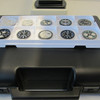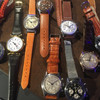

THOUGHT: What happened to the Breitling brand?
What is happening to the Breitling brand?
Where has the traditional spirit of the company gone, recognized for years thanks to its specific design, deeply rooted awareness, and models completely different from those offered by the competition? Why will there be no more winged "B"? Or what is Kern, the new CEO, up to? Does he want to destroy what Leon, Gaston, Willi, and later the Schneider family built?

These are questions that probably occurred to everyone who noticed the brand's new image or who is at least somewhat interested in the world of watchmaking. Concerns following the introduction of the new line, which was more of an expansion of the Navitimer collection with the Navitimer 8, only heightened the uncertainty of regular customers. What's more, now we have the new Premier line, and the number of pessimists is constantly growing. But are all these complaints, which are part of almost every discussion, justified? I will try to clarify at least some of the issues.
Breitling has always prided itself on its absolute independence and the advantage of not being part of any parent company. (Swatch Group, Richemont, LVMH, etc.)
The management of the company remained within the family, as did individual decisions about what, how, and for whom to produce. Breitling never had any ambitions to expand into Asia, which it made clear. This reluctance to conform is perfectly reflected in models such as the SuperAvenger with its impressive 48 mm diameter, the Chronomat 47 GMT, etc. Don't get me wrong, I'm not saying that's a bad thing. A large number of SuperAvenger models have been sold on the Slovak market. A unique, "muscular" design, robust and impressive watches. No longer as big, but rather iconic, was and is the Navitimer series, a model that was created in 1952 and remains an absolute staple and a favorite among aviation enthusiasts and lovers of the world around them.

All of these variations presented over the last few decades had a unique design that radiated masculinity. Even my favorite elegant Transocean series exuded testosterone in every detail.

So if everything is working, is change necessary?
In 2015, I had the opportunity to visit the Breitling factory, the headquarters in Grenchen, and the newly built Breitling Chronometrie in-house movement manufacturing facility in La Chaux de Fonds. There I learned that the company's annual production is approximately 180,000 pieces. I thought that was pretty good when I compared it to Omega with 800,000 pieces per year or Rolex with even higher production. If we look at it from this perspective, fewer pieces means greater exclusivity. (data valid in 2015). The difference in production is huge, and this brings us to the heart of the matter...


Turning point
In 2017, Breitling, which had been a family business until then, changed owners and came under the control of the foreign company CVC Capital Partners. The latter appointed Georges Kern to the management team, who moved to Breitling from IWC, where he had been CEO from 2002 to 2017. He significantly elevated the Schaffhausen-based manufacturer and brought it to the position it holds today. Before its acquisition by Richemont in 2000, IWC reported a turnover of USD 40 million, which rose to USD 779 million in 2016.
And now to the change. It is common for directors to come and go. One orders the closure of all sales outlets located in shopping malls, claiming that they are beneath them. The next one, immediately after taking office, orders the opening of new sales outlets, and where? In shopping malls, of course. We have seen this happen several times. In short, they have to show activity, and this is the easiest way.
In Kern's case, as he himself stated, it was necessary to press the RESET button. Fortunately, these steps did not lead to the closure of stores. However, it did affect boutiques, which were renamed and converted into lofts. Intimate places where customers can come to try on watches and enjoy a good rum, for example.

Among other things, after just a few days in charge, he decided to visit the largest Breitling watch collector in Vienna to learn more about the history of the models. I had the opportunity to meet this gentleman in person, and his collection is truly impressive, with hundreds of pieces dating back to the company's founding (photo below the text). Although Breitling has a wealth of documents, archives, and even a museum, the new director decided to take this route to familiarize himself with the company.


Perhaps thanks to these new insights, Kern decided to implement the aforementioned reset. He discovered that only 20% of potential watch buyers were attracted to the current design. The same is true for the Western market, not to mention Asia. Breitling has never been a brand that wanted to appeal to everyone, and it certainly never wanted to produce "delicate" watches—which is why we loved it. But sales and production figures force us to think. The truth is that these watches have sold and continue to sell very well in our market. Breitling is also adored in France. But on a global scale, that's probably not enough. Breitling is not Philippe Dufour and never will be... Another key point that Kern realized was that the company drew very little from its heritage and that a significant part of the brand's history was completely ignored. That's why we got the Navitimer 8, as I mentioned in my last article, and now the controversial Premier. (photos from the Breitling Premier presentation below the text)


Breitling wants to be accepted by a wider range of customers, wants to be much more readable and thus enable customers to better orient themselves. That is why the models are divided into four worlds (air, land, water, professional). The number of references has been reduced from approximately 600 to 150.
However, this does not mean that it will forget its strong connection to aviation, which remains a central pillar of the brand. Nor does it mean that it will no longer produce the watches we are used to.
I would rather say that we will see new models that will enrich the current displays and appeal to completely new customers who may never have considered this brand before. We will also no longer see scantily clad hostesses and similar sexism in marketing communications, as the new director wants to avoid this completely and instill stronger values in the brand that are now in vogue. This decision came at just the right time. Don't worry, models such as the SuperAvenger and Chronomat will not disappear – they will be presented in a new design. The classic Navitimer will not lose its identity, chronograph, and slide rule.
Just no more "Lady B" with bombs.
None of us can objectively say whether this decision was good or bad, or whether removing the wings from the logo was a good idea (it is a return to the original logo that was used until around the 1980s). We don't have a crystal ball to predict the future. The only thing that will show where the truth lies is the market and customers. There is a big difference between following comments under videos, discussions between "experts" and trolls on forums, and the behavior of classic customers, which has been confirmed a million times over. Personally, I am a fan of Breitling and look forward to more new creations under the leadership of Georges Kern and his team. I think he is the right person in the right place.
Introduction
My name is Martin Demko and I have been working with watches since 2011. During that time, I have handled many models, cheap and expensive, from renowned brands and lesser-known ones. My work is both a pleasure and a hobby for me. What I have always strived for and continue to strive for is maximum honesty towards customers, even at the expense of business. I have completed numerous courses and a considerable amount of training in Switzerland. If you like my articles and my subjective view on various issues, or if you disagree, feel free to write to me at m.demko@racio.com. I would be very happy to hear from you.



